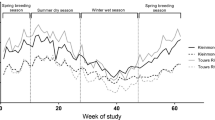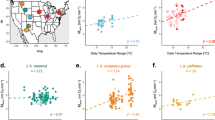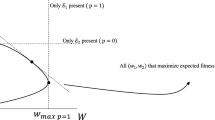Abstract
Natural populations are normally exposed to substantial environmental stress. The consequences of stress include elevated metabolic costs and additive genetic variability. From the former, preferred habitats should be located in environments corresponding to minimum total energy expenditure. This tendency occurs in the field for behavioral adaptation ofDrosophila to variable temperature (and humidity) conditions. Laboratory studies of resource preference inDrosophila suggest a low genetic variability. However, under more stressful field conditions, genetic variability should be higher. Habitat preference studies under stressful conditions therefore need to be emphasized in modeling situations in nature.
Similar content being viewed by others
References
Ames, D. (1980). Thermal environment affects production efficiency of livestock.BioScience 30:457–460.
Arking, R., Buck, S., Wells, R. A., and Pretzalff, R. (1988). Metabolic rates in genetically based long lived strains ofDrosophila.Exp. Gerontol. 23:59–76.
Atkinson, D. E. (1977).Cellular Energy Metabolism and its Regulation, Academic Press, New York.
Atkinson, W. D. (1981). An ecological interaction between citrus fruit,Penicillium moulds andDrosophila immigrans Sturtevant (Diptera: Drosophilidae).Ecol. Entomol. 6:339–344.
Barros, A. R., Sierra, L. M., and Commendador, M. A. (1991). Decreased metabolic rate as an acrolein resistance mechanism inDrosophila melanogaster.Behav. Genet. 21:441–451.
Boulétreau-Merle, J., Fouillet, P., and Terrier, O. (1987). Seasonal variations and balanced polymorphisms in the reproductive potential of temperateD. melanogaster populations.Entomol. Exp. Appl. 43:39–48.
Buchan, P. B., and Sohal, R. S. (1981). Effect of temperature and different sex ratios on physical activity and life span in the adult housefly,Musca domestica.Exp. Gerontol. 3:223–228.
Burnet, B., Connolly, K., and Mallinson, M. (1974). Activity and sexual behavior of neurological mutants inDrosophila melanogaster.Behav. Genet. 4:227–235.
Bush, G. L., and Howard, D. J. (1986). Allopatric and nonallopatric speciation: Assumptions and evidence. In Karlin, S., and Nevo, E. (eds),Evolutionary processes and Theory, Academic Press, New York, pp. 411–438.
David, J. R., Allemand, R., van Herreweg J., and Cohet, Y. (1983). Ecophysiology: Abiotic factors. In Ashburner, M., Carson, H. L., and Thompson, J. N., Jr. (eds),The Genetics and Biology of Drosophila, Vol. 3d, Academic Press, London, pp. 106–170.
De Kruijf, H. A. M. (1991). Extrapolation through hierarchical levels.Comp. Biochem. Physiol. 100C:291–299.
Derr, J. A. (1980). The nature of variation in life history characters ofDysdercus bimaculatus (Heteroptera: Pyrrhocoridae), a colonizing species.Evolution 34:548–557.
Diehl, S. R., and Bush, G. L. (1989). The role of habitat preference in adaptation and speciation. In Otte, D., and Endler, J. A. (eds.),Speciation and its Consequences, Sinauer, Sunderlan, MA, pp. 345–365.
Feder, J. L., Chilcote, C. A., and Bush, G. L. (1988). Genetic differentiation between sympatric host races of the apple maggot flyRhagoletis pomonella.Nature 336:61–64.
Fitt, G. P. (1986). The influence of a shortage of hosts on the specificity of oviposition behavior in species ofDacus (Diptera, Tephritidae).Physiol. Entomol. 11:133–143.
Fulker, D. W. (1966). Mating speed in PitDrosophila melanogaster: A psychogenetic analysis.Science 133:203–205.
Futuyma, D. (1989). Macroevolutionary consequences of speciation: Inferences from phytophagous insects. In Otte, D., and Endler, J. A. (eds.),Speciation and its Consequences, Sinauer, Sunderland, MA, pp. 557–578.
Futuyma, D. J., and Peterson, S. C. (1985). Genetic variation in the use of resources by insects.Annu. Rev. Entomol. 30:217–238.
Grant, P. R., and Grant, B. R. (1989). Sympatric speciation and Darwin's finches. In Otte, D., and Endler, J. A. (eds.),Speciation and its Consequences, Sinauer, Sunderland, MA, pp. 433–457.
Henderson, N. D. (1979). Adaptive significance of animal behavior: The role of gene-environment interaction. In Royce, J. R., and Mos, L. (eds.)Theoretical Advances in Behavior Genetics, Alphen den Rijn The Netherlands, pp. 243–284.
Henderson, N. D. (1981). Genetic influences on locomotor activity in 11-day-old housemice.Behav. Genet. 11:209–225.
Hochachka, P. W., and Somero, G. N. (1984).Biochemical Adaptation, Princeton University Press, Princeton, NJ.
Hoffmann, A. A. (1985). Interspecific variation in the response ofDrosophila to chemicals and fruit odours in a wind tunnel.Aust. J. Zool..33:451–460.
Hoffmann, A. A., and O'Donnell, S. (1990). Heritable variation in resource use inDrosophila in the field. In Barker, J. S. F., Starmer, W. F., and MacIntyre, R. J. (eds.),Ecological and Evolutionary Genetics of Drosophila, Plenum Press, New York, pp. 177–193.
Hoffmann, A. A., and Parsons, P. A. (1989a). An integrated approach to environmental stress tolerance and life-history variation. Desiccation tolerance inDrosophila.Biol. J. Linn. Soc. 37:117–136.
Hoffmann, A. A., and Parsons, P. A. (1989b). Selection for increased desiccation resistance inDrosophila melanogaster: additive genetic control and correlated response for other stresses.Genetics 122:837–845.
Hoffmann, A. A., and Parsons, P. A. (1991).Evolutionary Genetics and Environmental Stress, Oxford University Press, Oxford.
Hoffmann, A. A., and Parsons, P. A. (1992). Selection for adult desiccation resistance inDrosophila melanogaster: Fitness components, larval resistance and stress correlations.Biol. J. Linn. Soc. 48:43–54.
Hoffmann, A. A., and Turelli, M. (1985). Distribution ofDrosophila melanogaster on alternative resources: Effects of experience and starvation.Am. Nat. 126:662–679.
Hoffmann, A. A., Nielsen, K. M., and Parsons, P. A. (1984). Spatial variation of biochemical and ecological phenotypes inDrosophila: Electrophoretic and quantitative variation.Dev. Genet. 4:439–450.
Holloway, G. J., Sibly, R. M., and Povey, S. R. (1990). Evolution in toxin-stressed environments.Funct. Ecol. 4:289–294.
Homyk, T., Szidonya, J., and Suzuki, D. T. (1980). Behavioral mutants ofDrosophila melanogaster. III. Isolation and mapping of mutations by direct visual observations of behavioral phenotypes.Mol. Gen. Genet. 177:553–565.
Houle, D. (1992). Comparing evolvability and variability of quantitative traits.Genetics 130:185–204.
Huey, R. B. (1991). Physiological consequences of habitat selection.Am. Nat. 137:S91-S115.
Jaenike, J. (1990). Factors maintaining genetic variation for host preference inDrosophila. In Barker, J. S. F., Starmer, W. F., and MacIntyre, R. J. (eds.),Ecological and Evolutionary Genetics of Drosophila, Plenum Press, New York, pp. 195–207.
Jaenike, J., and Holt, R. D. (1991). Genetic variation for habitat preference: Evidence and explanations.Am. Nat. 137:S66-S90.
Jones, J. S., Coyne, J. A., and Partidge, L. (1987). Estimation of thermal niche ofDrosophila melanogaster using a temperature-sensitive mutation.Am. Nat. 130:83–90.
Kohane, M. J., and Parsons, P. A. (1986). Environment-dependent fitness differences inDrosophila melanogaster: temperature, domestication and the alcohol dehydrogenase locus.Heredity 57:289–304.
Kohane, M. J., and Parsons, P. A. (1987). Mating ability in laboratory-adapted and field-derivedDrosophila melanogaster: the stress of domestication.Behav. Genet. 17:541–558.
Miquel, J., Lundgren, P. R., Bensch, K. G., and Atlan, H. (1976). Effects of temperature on the life span, vitality and fine structure ofDrosophila melanogaster.Mech. Age. Dev. 5:347–370.
Obin, M. S., Van der Meer, R. K., and Ehrman, L. (1988). Sexual behavior. In Lints, F. A., and Soliman, M. H., (eds.),Drosophila as a Model Organism for Ageing Studies, Blackie, Glasgow, pp. 140–150.
Parsons, P. A. (1974a). Genetics of resistance to environmental stresses inDrosophila populations.Annu. Rev. Genet. 7:234–263.
Parsons P. A. (1974b). Male mating speed as a component of fitness inDrosophila.Behav. Genet. 4:395–404.
Parsons, P. A. (1975). The effect of temperature and humidity on the distribution patterns ofDrosophila inornata in Victoria, Australia.Environ. Entomol. 4:961–964.
Parsons, P. A. (1982). Acetic acid vapour as a resource and stress inDrosophila.Aust. J. Zool. 30:427–433.
Parsons, P. A. (1983). Ecobehavioral genetics: Habitats and colonists.Annu. Rev. Ecol. Syst. 14:35–55.
Parsons, P. A. (1987). Evolutionary rates under environmental stress.Evol. Biol. 21:311–347.
Parsons, P. A. (1988a). Evolutionary rates: Effects of stress upon recombination.Biol. J. Linn. Soc. 35:49–68.
Parsons, P. A. (1988b). Behavior, stress and variability.Behav. Genet. 18:293–308.
Parsons, P. A. (1991a). Evolutionary rates: Stress and species boundaries.Annu. Rev. Ecol. Syst. 22:1–18.
Parsons, P. A. (1991b). Can atmospheric pollution be monitored from the longevity of stress-sensitive behavioural mutants inDrosophila? Funct. Ecol. 5:713–715.
Parsons, P. A. (1992a). Fluctuating asymmetry: A biological monitor of environmental and genomic stress.Heredity 68:361–364.
Parsons, P. A. (1992b). Evolutionary adaptation and stress: the fitness gradient.Evol. Biol. 26:191–223.
Phillips, J. P., and Hilliker, A. J. (1990). Genetic, analysis of oxygen defense mechanisms inDrosophila melanogaster.Adv. Genet. 28:43–71.
Prince, G. J., and Parsons, P. A. (1980). Resource utilization specificity in three cosmopolitanDrosophila species.J. Nat. Hist. 14:559–563.
Rose, M. R. (1991).Evolutionary Biology of Aging, Oxford University Press, New York.
Ruiz, A., and Heed, W. B. (1988). Host-plant specificity in the cactophilicDrosophila mulleri species complex.J Anim. Ecol. 57:237–249.
Sibly, P. M., and Calow, P. (1989). A life-cycle theory of responses to stress.Biol. J. Linn. Soc. 37:101–116.
Sohal, R. S. (1986). The rate of living theory: A contemporary interpretation. In Collatz, K.-G., and Sohal, R. S. (eds.),Insect Aging, Springer-Verlag, Berlin, pp. 23–44.
Sohal, R. S., and Runnels, J. H. (1986). Effect of experimentally prolonged life span on flight performance of houseflies.Exp. Geront. 21:509–514.
Sokolowski, M. B., Bauer, S. J., Wai-Ping, V., Rodriguez, L., Wong, J. L., and Kent, C. (1986). Ecological genetics and behaviour ofDrosophila melanogaster larvae in nature.Anim. Behav. 34:403–408.
Trout, W. E., and Hanson, G. P. (1971). The effect of Los Angeles smog on the longevity of normal and hyperkineticDrosophila melanogaster.Genetics 68:s69.
Trout, W. E., and Kaplan, W. D. (1970). A relation between longevity, metabolic rate, and activity in shaker mutants ofDrosophila melanogaster.Exp. Gerontol 5:83–92.
Via, S. (1990). Ecological genetics and host adaptation in herbivorous insects: The experimental study of evolution in natural and agricultural systems.Annu. Rev. Entomol. 35:421–446.
Wcislo, W. T. (1989). Behavioral environments and evolutionary change.Annu. Rev. Ecol. Syst. 20:37–169.
Westerman, J. M., and Parsons, P. A. (1973). Variation in genetic architecture at different doses of γ-radiation as measured by longevity inDrosophila melanogaster.Can. J. Genet. Cytol. 15:289–298.
Zotin, A. I. (1990).Thermodynamic Bases of Biological Processes: Physiological Reactions and Adaptations, Walter de Gruyter, Berlin.
Author information
Authors and Affiliations
Rights and permissions
About this article
Cite this article
Parsons, P.A. Evolutionary adaptation and stress: Energy budgets and habitats preferred. Behav Genet 23, 231–238 (1993). https://doi.org/10.1007/BF01082460
Received:
Accepted:
Issue Date:
DOI: https://doi.org/10.1007/BF01082460




